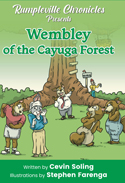
 |
A young squirrel named Wembley is lucky enough to make his home inside of a magnificent, huge oak tree. However, he lacks any humility about his fortune and often boasts to all of the other forest animals about the fact that his tree is the largest in all of Cayuga. This, of course, makes the other animals feel sad. When two “burly lumberjacks” arrive on the scene one day, they take notice of Wembley’s giant oak tree and begin to discuss its impressive nature. It must’ve taken “over three hundred years for nature to produce such a wondrous specimen,” they remark. They decide, as lumberjacks will do, to chop the tree down. First, though, they share a snack of crumpets and hot tea.
When Wembley overhears the men’s plans, he packs his things and tells his fellow forest animals, suggesting they can band together to oust the lumberjacks. They, however, are not too keen to go along with his plans, as they have grown so tired of his pride and constant bragging. Wembley takes the train to Florida. Meanwhile, the men take their chainsaws to the massive oak, and when it falls, it also topples other trees and a power line, igniting a fire that burns down half of the woods.
From the beginning of this humorous graphic novel, readers learn that the protagonist, Wembley, despite being a cute little squirrel, is one who doesn’t shy away from bragging and boasting. In fact, his braggadocious nature causes the other animals to feel, as Soling writes, “quite inferior.” This sentiment is so strongly shared by the other characters inhabiting the Cayuga Forest that, by the book’s end, the one thing making them feel a bit better about having lost wooded homes to a burning forest fire is the fact that Wembley’s loss is the greatest of all. After all, it was he who had lost “the most magnificent tree.” Thus, somewhere among the amusingly convoluted, sarcastically dark-humored, irreverent plot and zany characters who inhabit the world of this book, there can yet be found one simple, powerful, life lesson for adult readers and young people alike. The wisdom of modesty reigns supreme—the realization that no one person (or forest animal) is inherently better than anyone else. Certainly, making one’s home within the “biggest, most magnificent tree” does not equal superiority in character. If anything, it is the grand nature of Wembley’s tree that attracts those silly human lumberjacks sporting chainsaws and an appetite to cut it all down.
It should be noted, as is the case with the other delightfully over-the-top graphic novels comprising the Rumpleville Chronicles series, that author Soling and his crew of various illustrious illustrators seek to push the envelope. And that they do—to quite hilarious effect. In this title alone, lead character Wembley, after first hearing of the lumberjacks’ evil plans, gathers his nuts and “smokes a cigarette or two” before running off to inform the other creatures about the dire situation. Fellow Cayuga Forest resident Doris Deer is worried about having her “brains blasted all the way across Idaho.” Other animals are shown remembering with horror and sadness the fate of family members “trapped or wounded by hunters,” while all they could do was “stand by hopelessly” as their kinfolk passed away. One would not normally expect to find such material within the innocent pages of glossy, brightly illustrated children’s books. Significantly, the books in this series—while aesthetically appearing to be intended for children—are suited rather for adults (and perhaps older teens). Readers already familiar with the series will likely already know this. Without a doubt, Soling excels at that which he produces. His niche is well-established and well-earned.